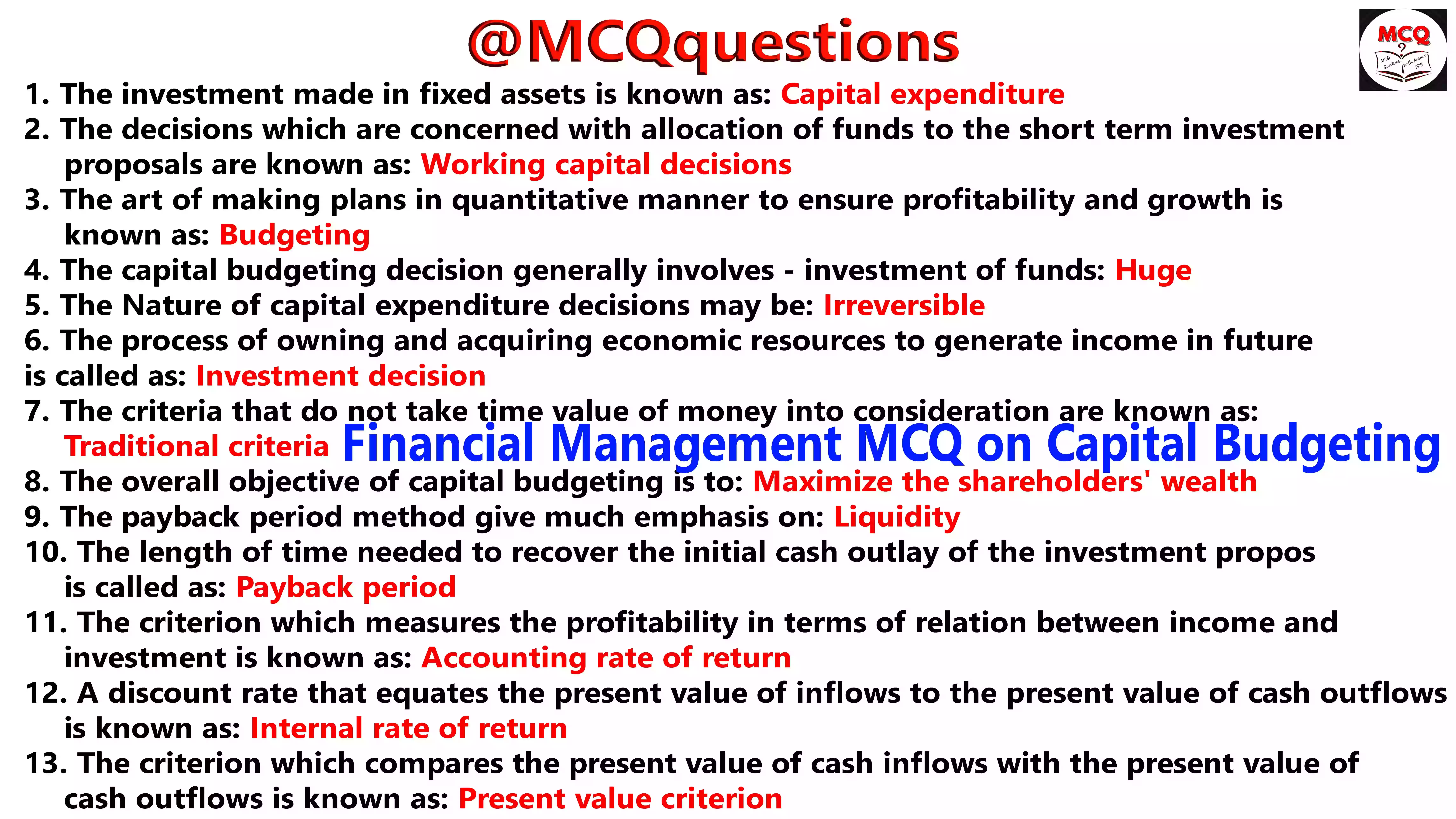Financial Management MCQ on Capital Budgeting

Financial Management MCQ on Capital Budgeting
1. The investment made in fixed assets is known as:
(a) Revenue expenditure
(b) Rental Expenditure
(c) Capital expenditure
(d) None of these
Ans-(c) Capital expenditure
2. The investment decision analysis encompasses the risk-return analysis of which of the following?
(a) Long term investment proposals
(b) Short term investment proposals
(c) Both of these
(d) None of these
Ans-(c) Both of these
3. The main components of capital budgeting are:
(a) Capital expenditure
(b) Budgeting
(c) Capital expenditure & Budgeting
(d) None of these
Ans-(c) Capital expenditure & Budgeting
4. The investment decisions which are concerned with the allocation of funds of an entity to the long term investment proposals are known as:
(a) Capital investment
(b) Capital budgeting
(c) Both of these
(d) None of these
Ans-(c) Both of these
5. The decisions which are concerned with allocation of funds to the short term investment proposals are known as:
(a) Capital investment
(b) Working capital decisions
(c) Capital budgeting
(d) None of these
Ans-(b) Working capital decisions
6. The art of making plans in quantitative manner to ensure profitability and growth is
known as:
(a) Budgeting
(b) Discounting
(c) Compounding
(d) None of these
Ans-(a) Budgeting
7. Financial managers consider capital budgeting as a very important function of finance due to:
(a) Large Investment
(b) Long term Effect on Profitability
(c) Long Term Commitment of Funds
(d) All of these
Ans-(d) All of these
8. The capital expenditure decisions encompass the decisions relating to:
(a) Independent investment proposals
(b) Mutually exclusive investment proposals
(c) Contingent investment proposals
(d) All of these
Ans-(d) All of these
9. The capital budgeting decision generally involves – investment of funds.
(a) Meager
(b) Huge
(c) Small
(d) No
Ans-(b) Huge
10. The examples of capital expenditure is :
(a) Purchase of fixed assets
(b) Replacement of fixed assets
(c) Alteration to the fixed assets
(d) All of these
Ans-(d) All of these
11. The Nature of capital expenditure decisions may be
(a) Reversible
(b) Routine
(c) Irreversible
(d) None of these
Ans-(c) Irreversible
12. The process of owning and acquiring economic resources to generate income in future
is called as:
(a) Financing decision
(b) Dividend decision
(c) Investment decision
(d) None of these
Ans-(c) Investment decision
13. Which of the following network techniques help in monitoring the implementation of the approved proposals?
(a) Critical Path Method (CPM)
(b) Programme Evaluation Review Technique (PERT)
(c) Both of the above
(d) None of these
Ans-(c) Both of the above
14. The criteria that do not take time value of money into consideration are known as:
(a) Discounted criteria
(b) Either (a) or (b)
(c) Traditional criteria
(d) Neither (a) nor (b)
Ans-(c) Traditional criteria
15. The final approval of investment proposals is based on:
(a) Financial viability
(b) Economic constituents
(c) Profitability
(d) All of these
Ans-(d) All of these
16. The overall objective of capital budgeting is to:
(a) Maximize the shareholders’ wealth
(b) Reduce costs
(c) Increase revenues
(d) None of these
Ans-(a) Maximize the shareholders' wealth
17. The payback period method give much emphasis on:
(a) Profitability
(b) Whole life earnings
(c) Liquidity
(d) Time factor
Ans-(c) Liquidity
18. The traditional criteria encompasses:
(a) Accounting rate of return
(b) Payback period
(c) Both of these
(d) None of these
Ans-(c) Both of these
19. The length of time needed to recover the initial cash outlay of the investment propos
is called as:
(a) Payback period
(b) Return period
(c) Accounting period
(d) None of these
Ans-(a) Payback period
20. The criterion which measures the profitability in terms of relation between income and
investment is known as:
(a) Payback period
(b) time value of money
(c) Accounting rate of return
(d) None of these
Ans-(c) Accounting rate of return
21. A discount rate that equates the present value of inflows to the present value of cash outflows is known as:
(a) Rate of return
(b) Cost of capital
(c) Internal rate of return
(d) None of these
Ans-(c) Internal rate of return
22. The advantages of accounting rate of return criterion are:
(a) Takes whole life earnings
(b) Emphasis on profitability
(c) Easy computation
(d) All of these
Ans-(d) All of these
23. The criterion which compares the present value of cash inflows with the present value of
cash outflows is known as:
(a) Present value criterion
(b) Accounting rate of return criterion
(c) Payback period criterion
(d) None of these
Ans-(a) Present value criterion
24.what is the acceptance rule of payback period ?
(a) Select the investment proposal with highest payback period among all investment proposals
(b) Select the investment proposal with lowest payback period among all investment Proposals
(c) Either (a) or (b)
(d) Neither (a) nor (b)
Ans-(b) Select the investment proposal with lowest payback period among all investment Proposals
25. The merit of present value method is/are:
(a) It takes time factor into consideration
(c) It takes whole life earnings
(b) Both of these
(d) None of these
Ans-(b) Both of these
Also Read Financial Management MCQ
